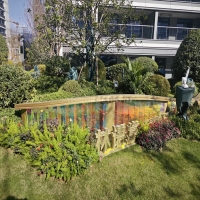Welcome to the website for landscape facilities products and knowledge.
What is the table’s resistance to fading or discoloration over time?
When investing in quality furniture, particularly tables, one crucial question often arises: What is the table's resistance to fading or discoloration over time? This concern goes beyond mere aesthetics, touching upon the longevity and value retention of your furniture piece. The resistance to color degradation primarily depends on several key factors including material composition, protective finishes, and environmental exposure.
High-quality tables typically incorporate advanced technologies to combat fading. Many premium tables feature UV-resistant coatings that act as a protective shield against the sun's harmful ultraviolet rays, which are the primary cause of color fading. These specialized finishes contain absorbers or blockers that prevent UV radiation from breaking down the chemical bonds in dyes and pigments, thereby preserving the original color integrity.
The core material of the table plays an equally important role in color retention. Solid wood tables, for instance, often develop a patina over time rather than fading unevenly, while manufactured wood with proper veneers can maintain consistent coloring. Metal tables with powder-coated finishes demonstrate exceptional fade resistance, as the coloring is baked into the material at high temperatures, creating a durable, long-lasting surface.
Environmental factors significantly influence how quickly a table might discolor. Tables placed in direct sunlight will naturally experience faster fading than those in shaded areas. Similarly, tables exposed to harsh weather conditions, high humidity, or temperature fluctuations may show color changes more rapidly. Modern manufacturing techniques have addressed these challenges through improved material engineering and protective coatings that create barriers against environmental stressors.
Maintenance practices also contribute substantially to a table's color preservation. Regular cleaning with appropriate products removes contaminants that could accelerate discoloration. Using protective pads, avoiding harsh chemicals, and implementing periodic reconditioning with recommended products can extend the vibrant appearance of your table significantly.
Manufacturers conduct accelerated aging tests to determine fade resistance, exposing materials to intense UV light and varying conditions to simulate years of use within weeks. These tests help establish fade resistance ratings, allowing consumers to make informed decisions based on their specific needs and environmental conditions.
The integration of nanotechnology in furniture finishes has revolutionized fade resistance. Nano-ceramic coatings provide microscopic protection that traditional finishes cannot match, offering enhanced durability against both UV radiation and everyday wear. This technological advancement represents the cutting edge of furniture preservation, ensuring tables maintain their aesthetic appeal for decades.
Ultimately, a table's resistance to fading represents a combination of material science, manufacturing quality, and proper care. By understanding these factors, consumers can select tables that will retain their beauty and functionality through years of use, making informed choices that align with their lifestyle and environmental conditions.
Related search:

Recommendation
Metal and acrylic color-changing combined curtain wall for large-scale public landscape facilities